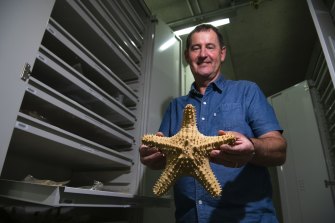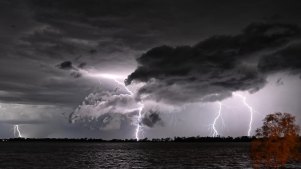Snorkelling among grey nurse sharks, turtles and fish on the Mid North Coast isn’t a normal way to spend science class.
But for the students at Great Lakes College in Tuncurry, it’s just another day at school. That was until they spotted a tropical sea starfish species that has not been seen in the area for 12 years.
Science teacher Simon Patterson and his year 9 students were snorkelling at Wallis Lake at the end of 2020 when they spotted a number of starfish they were unable to identify.

|
|
A Pentaceraster regulus, found on the NSW coast. The species
normally lives more than 600 kilometres further north.
|
The museum’s Marine Invertebrates Collection Manager Stephen Keable received the enquiry and realised the invertebrate had been spotted in the same area 12 years ago.
The large starfish, known as Pentaceraster regulus, is usually found more than 600 kilometres away, along the Queensland coast and have also been found near Lord Howe Island.
“Because there were only two individuals of this species found in 2008, it was thought that they may have been brought into the area by vessels entering the nearby marina,” Dr Keable said.
But he said the new information provided by the students provided evidence that the presence of the species was not a one-off event.
”Whether this particular sea star will have an impact, it is hard to know: it is large, it is a predator, it already occurs there quite commonly at certain times.
“It’s impacting the local environment somehow, but there needs to be some fairly detailed research.“
Year 11 student Baden Bell, who is considering a career as a marine biologist, said spotting the starfish was exciting to find but raised concerns about climate change.
“Climate change could have impacted the environment and moved it more south, we don’t know what the effects will be on our local ecosystem,” the 16-year-old said.
“It was a great experience to be a part of. We are not only observing and looking at starfish, but we also got to capture them and collect them and talk to scientists.”

|
|
Australian Museum marine invertebrates collection manager Dr
Stephen Keable holds Pentaceraster regulas.
Credit: Rhett Wyman
|
Extreme weather
|
| Sydney smashes January humidity records as La Nina nears its peak |
The collection plays a vital role in documenting where species originate, how they change over time as well as providing insight into the biodiversity of a region.
Warming oceans are thought to be responsible for the starfish’s expansion to the small coastal town, and its presence is indicative of the impacts of climate change on marine ecosystems.
The world’s oceans recorded their hottest year in more than 60 years, with the past five years the warmest on record, and scientists are concerned about how marine life would be able to adapt.
Please Explain podcast |
| What is the impact of the maritime heatwave? |
Since 2003, about 198 species have changed their distribution ranges – 87.3 per cent of these have shifted poleward.
Centre for Marine Socioecology Director and Institute for Marine and Antarctic Studies Professor Gretta Pecl, who published the research with colleagues in 2020, said some species would significantly impact their new ecosystem structure and function, human health and food security.
“The fact these species are adjusting their distribution is a positive sign, they are adapting to the climate. We want to adapt, it’s just that the rate of change in different species is different,” she said.
“I think of ecosystems and distribution of species as an ecological fabric of the planet, the threads are being pulled at different rates, creating holes and clumps and changes to the fabric: not everything can shift at the same rate.
“That means that all those connections, all of those threads are all changing. It is a bit of a nightmare, trying to establish what the net effect of all those are.”
Links
- Marine climate responses - CSIRO
- Ocean Sustainability and Climate Change
- Climate Change - Great Barrier Reef Foundation
- ‘Magical to witness’ underwater discovery proves how little we know about the ocean
- Turbulent La Nina season makes it even harder to predict the weather
- Sydney smashes January humidity records as La Nina nears its peak
- The coal man with the fate of the world in his hands

No comments:
Post a Comment